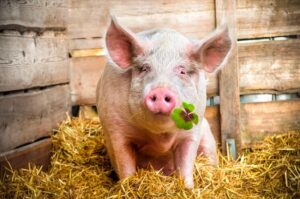The fact that giraffes are skilled fighters, can gallop fast, and were given as gifts by ancient Egyptian kings to showcase their power are little-known facts about this seemingly familiar animal. If you love this animal and want to know more Interesting Facts About Giraffes, join KnowAllAnimals to explore them in the following article!
1. A Brief Look at Giraffes
The giraffe, scientifically known as Giraffa, is the tallest terrestrial mammal and the largest ruminant currently in existence. It is famous for its long neck and majestic stature. They live primarily in the savannas, grasslands, and open woodlands of Africa.
With their remarkable height and unique coat patterns, giraffes are not only a symbol of biodiversity but also one of the most beloved animals in zoos and wildlife preserves around the world.
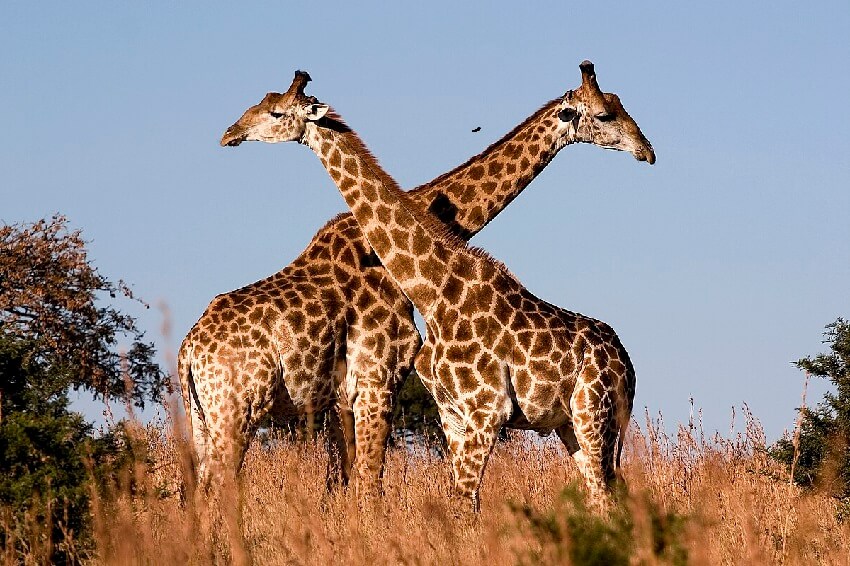
1.1. Common Subspecies
Giraffes are divided into several different subspecies based on their physical characteristics and geographical distribution. The most common subspecies include:
- Masai giraffe: Often found in Kenya and Tanzania, this species has irregular, often maple-leaf-shaped spots.
- Nubian giraffe: Lives in northeastern Africa, with large spots and clear white borders.
- Southern African giraffe: Found in South Africa, Namibia, and Botswana, this species has large spots that are fewer in number compared to other subspecies.
- Reticulated giraffe: Primarily distributed in northern Kenya, characterized by its rectangular, net-like pattern.
1.2. Identifying Features
Giraffes are easily recognizable by their unique appearance. The first thing you’ll notice is their incredibly long and impressive neck, which can reach up to 2.4 meters (8 feet) long, allowing them to reach the fresh, high branches that they love.
Their coat has a distinctive pattern of dark spots (brown or black) on a light background (pale yellow or cream). While they may look similar to the naked eye, each individual giraffe has a unique pattern, much like a human fingerprint.
In addition, this animal has long, slender legs, large ears, and especially large eyes that give them a wide field of vision to watch for predators. Their long tails help them swat away insects and also add to their graceful appearance.
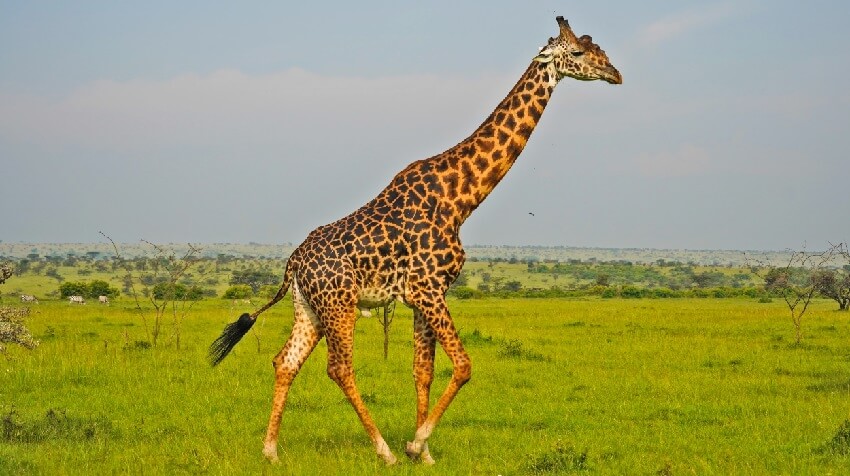
1.3. Giraffe Behavior
Giraffes typically live in herds, which can range from a few individuals to more than 20. A herd usually consists of females and their young, while adult males often live solitary lives or in small bachelor groups. There is no strict hierarchical system within the herd, unlike many other animal species.
They also have a few characteristic behaviors:
- Eating habits: Giraffes are herbivores, mainly eating leaves, flowers, and fruits. Their long necks allow them to access food sources high up that many other animals cannot reach, especially acacia trees. They can eat continuously for many hours, about 16-20 hours a day.
- Reproductive habits: The breeding season for giraffes is not fixed and depends on environmental conditions. Males often fight each other for the right to mate with females.
- Sleeping habits: Giraffes have short sleep cycles, usually only about 4-6 hours a day. Notably, they have a habit of sleeping while standing to easily escape from predators.
2. Amazing and Interesting Facts About Giraffes for Animal Lovers
Discover the surprising and fascinating facts about the giraffe—the world’s tallest animal. This article shares engaging knowledge for all animal lovers.
2.1. Complex Mating Habits
The mating habits of giraffes are quite complex because females often refuse to mate during their 15-month gestation period. In between pregnancies, a female giraffe may mate with a suitable male, but only during a short, two-week-long cycle.
This allows the females to track when the males are ready for mating. When they display a behavior called “flehmen,” the female will urinate into the male’s mouth. The taste of a female’s urine when she is ready to mate is different from normal.
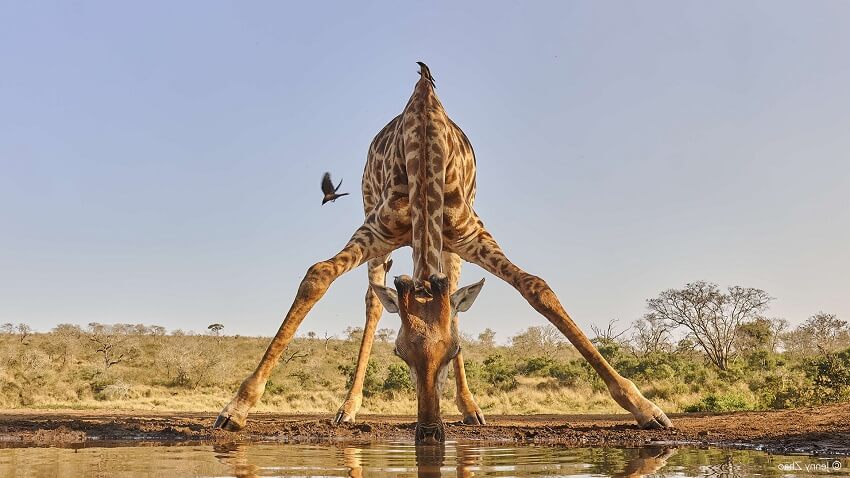
2.2. How Giraffes Helped NASA
When in space, blood flow is different from a normal state. The circulatory system in a person’s legs does not have to work to pump blood back, causing the veins to become inactive and weaken, which is dangerous for humans upon returning to Earth.
Meanwhile, baby giraffes can learn to stand immediately after birth because of their rapidly developing venous system in their legs. When NASA observed this, they created a device consisting of a sealed tube that is wrapped around the astronauts’ waists and applies a vacuum, which causes the leg veins to expand and blood to circulate normally.
2.3. Drinking and Water Conservation
Drinking water is a serious issue for giraffes. To drink, they have to awkwardly spread their front legs and lower their necks, a position that makes them vulnerable to predators like crocodiles. However, a giraffe’s digestive system can absorb almost all of the water they need from the plants they eat.
This method is quite effective for young, vulnerable giraffes. Giraffes never sweat or pant to cool down. Instead, they allow their body temperature to fluctuate with the surrounding temperature to conserve water.
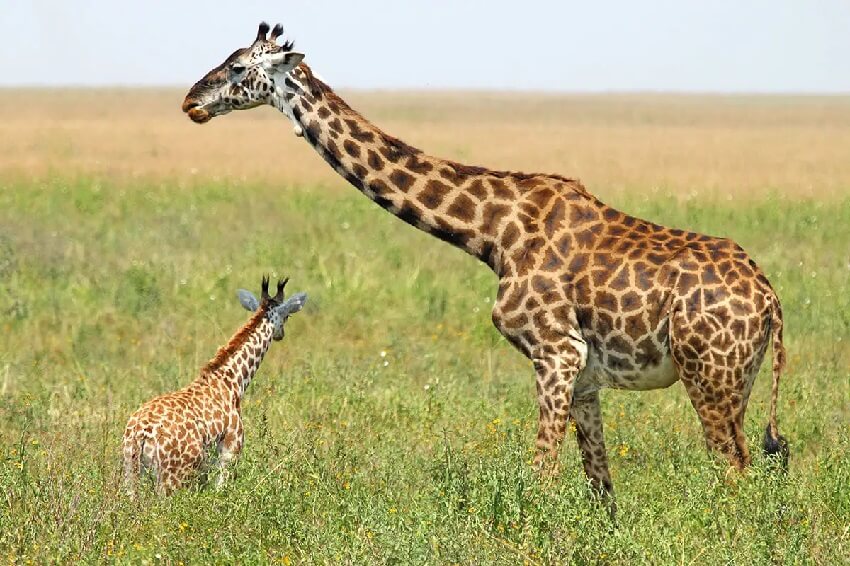
2.4. Giraffes Can Gallop
Despite their clumsy appearance, the speed of these animals is quite astonishing. Giraffes have two modes of fast and extremely fast movement, which scientists call walking and galloping. Each of a giraffe’s walking strides can be 4.5m (15 ft) long, which means that when walking, their speed is about 16 km/h (10 mph). When galloping, a giraffe can reach a speed of 56 km/h (35 mph).
2.5. Skilled Fighting Techniques
With their extremely fast galloping ability, giraffes can defend themselves and escape when attacked by a predator. Giraffes are such skilled defenders that even lions only dare to attack when they are with other lions in a pride. A giraffe’s legs are very strong and have thick, sharp hooves that are about 30 cm (12 inches) long. A single kick from a giraffe can kill a lion.
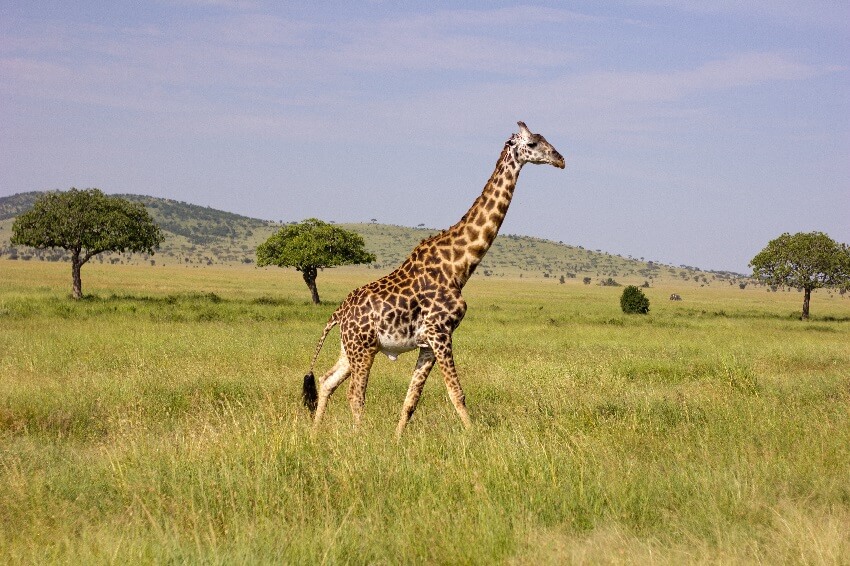
2.6. The Giraffe Dance
Due to their captivating appearance and hidden strength, giraffes are considered a symbol in many traditional African belief systems. One of these peculiar beliefs is the “giraffe dance.”
This dance originated from a woman who dreamed of a giraffe running in the rain. The sound of its hooves and the raindrops created a special melody that was later called the “giraffe melody.” For centuries, the Bushmen of the Kalahari region have used this melody in their hunting dances.
2.7. “Neck-ing” to Show Who is Stronger
Male giraffes strike, rub, and twist their necks together to see who is stronger. Although this “necking” makes them look very cute, these fights can be quite strenuous and last for 20 minutes. However, this behavior is also a way for the male giraffes to attract the attention of females.
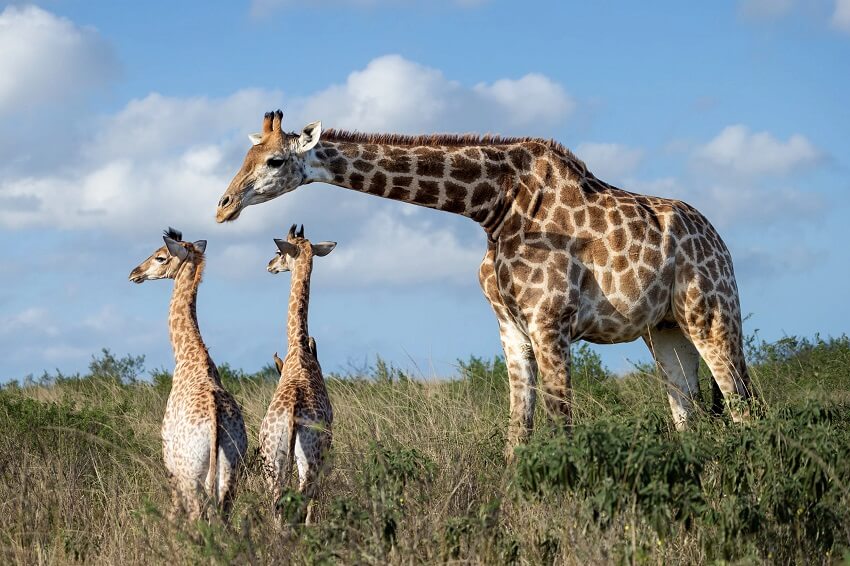
2.8. The Wonders of the Mouth and Tongue
A giraffe’s tongue is approximately 50 cm (20 inches) long. Its tongue is blue-black to protect itself from the sun’s rays, and the giraffe uses its tongue to grasp objects, scratch its nose, and clean its ears, similar to the function of an elephant’s trunk. This snake-like tongue is particularly useful for foraging, as the giraffes only need to lick around the foliage, give a strong tug, and then bring the leaves into their mouths.
The giraffe’s large upper lip can act as an arm when combined with its tongue. The insides of its mouth, along with its lips and tongue, are covered with tough, finger-like papillae to protect them from thorny bushes and injuries.
2.9. Giraffes as Gifts and Symbols of Power
As early as 2500 B.C., ancient Egyptian kings would capture giraffes and parade them before their people. Considered impressive and elegant animals, giraffes were eventually used as gifts and as a way for rulers to showcase their power. Julius Caesar, a famous ruler of ancient Egypt, once received a giraffe as a gift and paraded it through Rome. Afterward, the giraffe was taken to a coliseum and fed to lions to demonstrate Julius Caesar’s power.
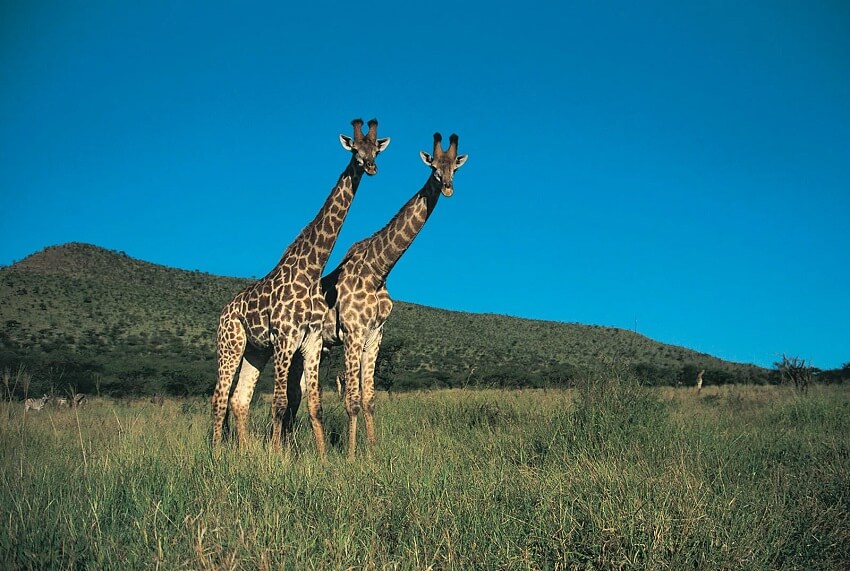
2.10. Zarafa the Giraffe
Zarafa was the first giraffe given as a royal gift by Muhammad Ali, the Ottoman viceroy of Egypt, to King Charles X in October 1826. During her procession from Marseilles to Paris, Zarafa was admired by many people. The giraffe was later written about by famous authors, used as inspiration by artists, and women began to style their hair and wear clothes in the giraffe style, with furniture and decorations becoming a popular trend at the time.
2.11. Other Interesting Facts About Giraffes
Giraffes are the tallest mammals in the world; their legs alone are as tall as an adult human, at about 180cm (6 feet).
Giraffes only need to drink water once every few days. They get a large amount of water from the plants they eat.
Giraffes spend most of their lives standing, and they even sleep and give birth in this position.
A baby giraffe can stand up and walk a few hours after birth. After a few weeks, they begin to forage for their first leaves.
Despite being carefully protected by their mothers, many young giraffes are attacked and eaten by lions, leopards, and African wild dogs in their first few months of life.
A giraffe’s spots are like human fingerprints. No two individuals are exactly alike.
Both male and female giraffes have two horns; the furry areas on top of their heads are called ossicones. Sometimes, male giraffes use their ossicones to fight with other males.
Giraffes only sleep for about 5 to 30 minutes a day. They typically only sleep in short bursts of about two minutes at a time.
Giraffes often make grunting, snorting, and hissing sounds.
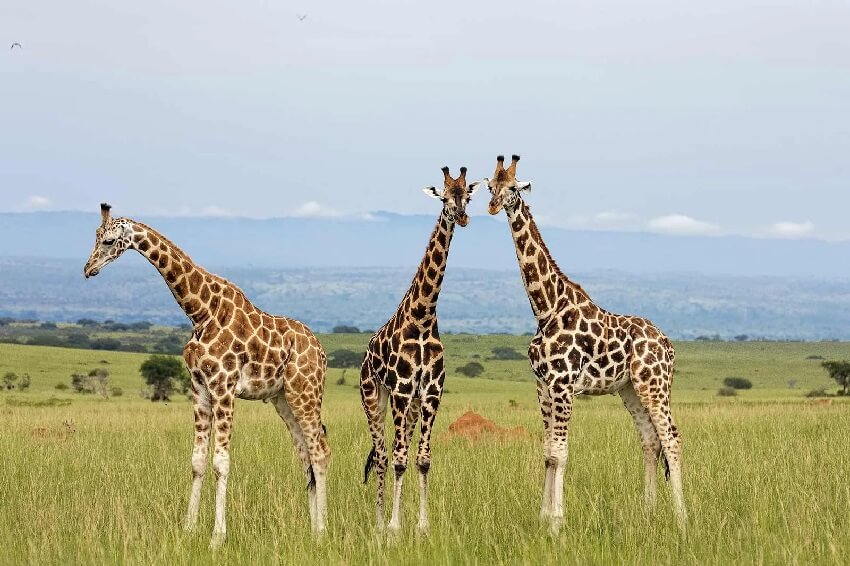
3. FAQs
1. Why do giraffes have to spread their front legs to drink water?
Spreading their legs helps giraffes lower their necks to reach the water’s surface, but it also increases their risk of being attacked by predators like crocodiles.
2. How fast can a giraffe run when “galloping”?
When running fast (“galloping”), a giraffe can reach speeds of up to about 56 km/h (35 mph).
3. What are the special features of a giraffe’s tongue that help it eat leaves effectively?
A giraffe’s tongue is about 50 cm (20 inches) long and is blue-black to protect it from the sun’s rays. Its upper lip and tongue work together to pick leaves from the canopy, and the inside of its mouth has tough papillae to protect it from thorns or injuries.
4. How long does a giraffe sleep each day?
Giraffes sleep very little, for about 5 to 30 minutes a day, and typically in short naps of about a few minutes at a time.
5. Is there anything special about how male giraffes compete for mating rights?
Males use “necking”—striking, rubbing, and twisting their necks together—to see who is stronger. This behavior can last for about 20 minutes.
Giraffes are not only known for their characteristic long necks but also harbor many interesting facts that make them a special animal in the natural world. We hope this information about Interesting Facts About Giraffes has given you a fresh perspective on this incredible animal. If you are an animal lover, don’t forget to keep exploring more fascinating stories about the wild world.

